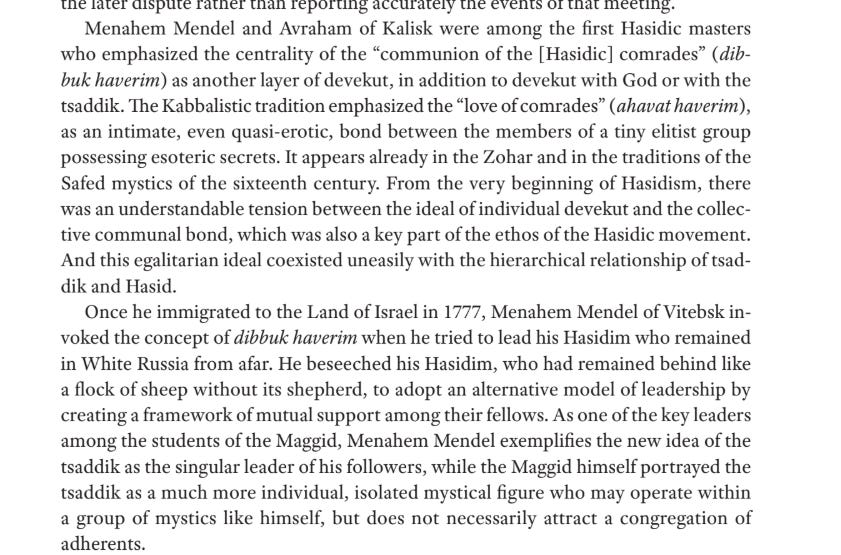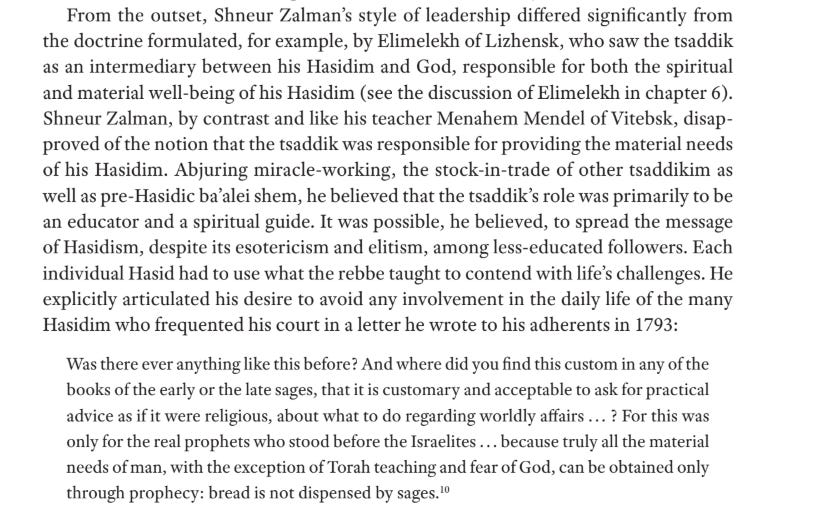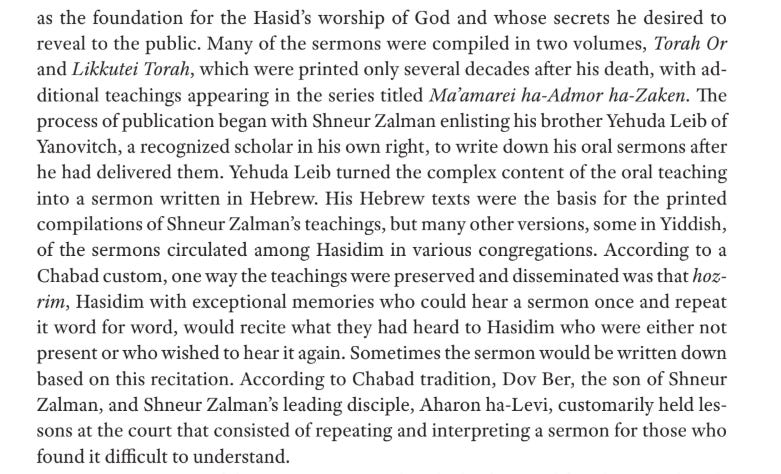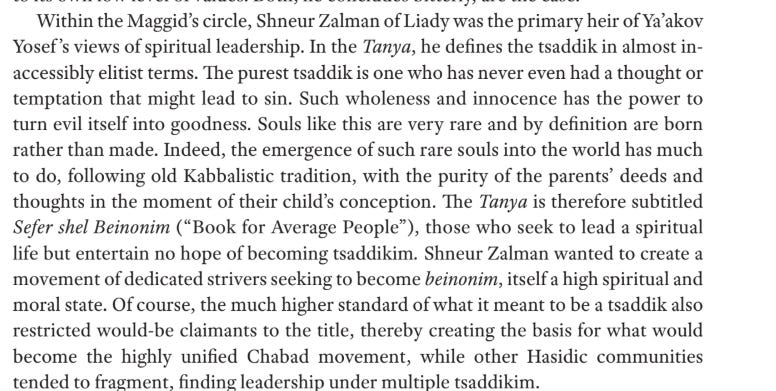Notes on Books I've Read: The Big Book o' Hasidism, Part One
Technically its actual title is "Hasidism: A New History" but I like calling it "The Big Book o' Hasidism"
This book was fun.
It’s gigantic and can be used as a doorstop, and I threw my back out holding it while reading it, but its eminently readable, packed with fun facts and anecdotes and not too dense of a style. Credit to the editors for keeping the tone consistent despite the book being written by 8 different people (all men, as has been pointed out). Since it’s a large book, I won’t be doing this all in one go, and will break it up into parts. Fortunately, the book itself is also broken up into parts, so I will at least attempt to stick to their division, part 1 being the 18th century and the beginnings of the Hasidic movement, part 2 being the 19th century, and part 3 being the 20th century.
Without further ado:
Page 18-19
Interesting that the soil from which the Hasidic movement sprang was this one, known for malcontents and heretics. We know that this was where Jacob Frank made his home (and the free passage between Ottoman Turkey and Podolia was a factor in his coming there). This isn’t to say that Sabbateanism and Hasidism are linked, that’s a whole can of worms, but it is interesting that there was such an environment in Polish Jewry that was known as Misfit Land. As a connoisseur of Misfits in the Jewish tradition, that intrigues me.
Page 25
Flagged this because I had been reading Erich Hobsbawm’s book on Bandits and he talks about these guys and I had wondered what those guys had thought about Jews. Turns out, nothing good. Hobsbawm’s not great about Jews either, and there’s something to be said about people primarily identifying anti-semitism as a top-down phenomenon, like in Nazi Germany, of the state persecuting a minority, when a lot of times in Europe it was a bottom up phenomenon, of a peasant class rebelling against the perceived holders of capital and power, which the real holders of capital and power were glad to encourage because it meant less heat on them. This stuff worries me, which is why I bury my head in my books these days instead of weighing in on current events. Anyway.
Page 28
This is actually very important for the history of Hasidism (I use “Hasidism” to refer to the movement and “Chassidus” to refer to the thought of said movement). The Jewish councils that had been running autonomous Jewish self-government were, in the same time period that Hasidism was ascending, being destroyed by the Polish government which was itself strapped for cash, and oppressing the Jews has historically been governments’ ways of checking the seat cushions for change. In other words, the infrastructure of the Jewish community was being destroyed, and it’s very important to understand Hasidism as responding to that problem. It also exacerbated the problem, which is one of the reasons it encountered opposition, as we’ll see, but they should be understood, in my opinion, as adapting to a new reality.
Page 29
Like I’m saying, Hasidism was preparing for a reality that would happen when the Kahal, with its system of enforced taxation based on pre-modern infrastructure, was destroyed, by having its own system of voluntary taxation that corresponded to the more voluntary forms of communal identification that modernity would bring. And one of the themes of this book and of Hasidic history is that Hasidism is a modern movement that arose out of the challenges of modernity, and that the maintenance of traditional forms of life required, paradoxically, innovation. In order for the Kahal life to be maintained in the modern era, it had to adapt to modernity and the forms it would take, and that’s what Hasidism is.
Page 30
That said, its cool to see how pre-modern institutions were more adaptable and “progressive” than you may assume, and it’s good that there were functioning checks on power within the Jewish community. Also important for Hasidic history is that this system of havurot was used by Hasidism for its own advantage to legitimize their separate minyanim and shtibls.
page 31
That’s a really interesting parallel, and I suspect they’re being too cautious in assuming that there was no influence or imitation. You don’t have to be in contact with or even like non-Jews to see what’s going on around you.
Page 33
So one of the crises going on in the world that birthed Hasidism, is that because of the squeeze on communal funding there’s squeezing of educational funding, to the point that now only people of means can get a good Jewish education. This is a subject dear to my heart, and I am happy that this aspect of the romantic vision of the beginnings of the Hasidic movement, that it was responding to inequities in education, bears out in the reality.
Page 34
Really interesting stuff about increased participation of women in religious life in the era in which the Hasidic movement ascended. The problem is that, at least in the evidence they present, Hasidism rolled back this progress. And that makes sense, as I do think that an underrated force that creates social movements, for better or for worse, is men’s desire to get away from their wives/create men’s only spaces. I’m not happy about this, but it seems like its very common throughout history. I have a pet theory that political society and the move to patriarchy happened as a result of this phenomenon, but that’s too far afield for this. Also note the role that printing plays here in democratizing knowledge, even kabbalistic knowledge.
Page 36
As I was saying, the role printing plays in democratizing knowledge is important, but, and this is a hugely important theme for not just this but all of Judaism, democratizing knowledge through the written word also makes it less flexible and adaptable. Even though there’s something still to be said for the ways text can be interpreted versus how oral traditions tend to be actually more rigid, the democratization/flexibility trade off is a theme that recurs over and over in Jewish history every time there’s a codification of halakha.
Now we go from background into discussing the Baal Shem Tov.
page 48
What goes unremarked upon here but is really interesting to me, is that he’s actually going against halakha to protect a woman here. She did, in fact, commit adultery, but the Besht saves her life! And her repentance is seen as due to his intervention; he keeps her frum, so to speak, rather than have her punished for her crime or have any legal consequences for it. Granted, he doesn’t free her, but there’s something really interesting about the relationship the Baal Shem Tov has to halakha in this story.
Page 53
So one of the things that’s very stressed in the primary sources that academics have only really begun to take seriously is that the Besht was a guy who was able to have mystical visions. Numerous accounts of him going into trances and seeing visions, including our only primary source from him himself. It wasn’t just his charisma that got him followers, it was his shamanic abilities, the ability to enter and emerge from mystical visions and articulate them to others. But what he really innovates is his attitude towards such states; instead of aspiring to a constant state of ekstasis, its the cycle of ecstacy and return to normality which is important. This is not only important for understanding Chassidus, but also good general advice. You can’t be on all the time. The desire for constant union or constant pleasure is an unhealthy one. You have ups and downs. The ups keep you going during the downs, and the downs make you appreciate the ups. The man had genuine insight into human beings. That’s why people followed him!
I don’t have as many notes on the Besht as I would maybe like, but it’s a long book!
Page 61, talking about an interesting figure who seems crucial.
So some important things here
1. This is in the midst of a longer discussion about how there likely was no formal “circle of the besht” but a group of people who were drawn to him who knew each other informally, and sometimes never even met. R. Baruch doesn’t cite the Besht but seems to have been in his circle of influence.
The point about “old style hasidim” is one made in the book, that there had long been informal circles of kabbalistic study and pietistic practices, but these groups were not a mass movement and were elitist by nature. And R. Baruch is a transition figure between the hasidim and Hasidism. R. Yaakov Yosef of Polonoye, for example, was clearly an elitist who wanted his congregants to stop bothering him so he could focus on Kabbalah, but credits the Baal Shem Tov with helping him realize that he had to meet his congregants where they were at and he had a responsibility to them.
The fact that psychologization of Kabbalah, a key component of Chassidus and Hasidism, that enabled it to become a mass movement by turning it into something more digestible to the masses, begins with him seems important.
No flags on the Maggid of Mezritch section until page 97
In the midst of talking about fights between Hasidim and Misnadgim, which they argue are overrated historically.
Interesting how Pinsk seems to have not cared that much about Hasidim. I wonder what was responsible for that. Maybe I read about it in Section 2 and forgot about it. It couldn’t have hurt that, by all accounts, R. Levi Yitzchak of Berditchev was an absolute sweetheart. Not only are there legends of his ability to relate to simple Jews, he was one of the only Hasidic rebbes who got along with Rebbe Nachman, which was….difficult.
Page 99, summing up the circle of the Maggid.
As I stress constantly, the influence of organized groups in Jewish history is overrated and the influence of amorphous circles of influence is underrated. The Maggid did not have a school, he had people who learned with him, discussed things with him, and took from him different ideas relating to their own personalities.
We now skip way ahead to page 120, skipping the sections on Chernobyl, Berditchev and Breslov. You can read about Breslov elsewhere, I’m sorry I didn’t tag anything about Berditchev, and Chernobyl will come back with a vengeance. Anyway.
This seems like a cool religious basis for an egalitarian/anarchistic ideology, which is the kind of thing that intrigues me. The thing is, it didn’t work, and most of the Vitebsker chassidim left for other rebbes. But still! Cool concept!
Page 126, we come to Chabad.
Very interesting that Chabad, at its outset, was not operating with an idea of the Tzaddik that would eventually become dominant. The Baal HaTanya seems to have seen himself as first and foremost an educator, not as an esctatic mystic or a miracle worker. The problem is that he was such a great educator and organizer that he was extraordinarily successful at gaining adherents. So using his organizational genius, he basically had a beuracratic infrastructure running his court and the far off institutions.
Like, look at this:
One of the things that comes out from this book: Chabad has always been astoundingly competent. The reason they’re so big is because they have always been extremely good at what they do.
page 130
I’m always interested in pedagogy of the past, how large amounts of information were transmitted from person to person. The idea of “hozrim”, people with good memories who could recite the sermon to be written down later, has parallels with what we know about early Torah she’baal Peh, where the lesson depended on “reciters” of the Mishnah.
Skipping ahead to Galicia and Central Poland:
Page 144
Ok, you have my attention. I guess anyone who likes Izhbitz who’s looking for some untrodden ground, go look this guy up? .
That said, this betrays something about the authors and of academic study of Chassidus. Why is this guy of “special importance” if his works were not published until 1961? Important to who? To Chassidim? Or to people who have no interest in Jewish texts unless they’re “interesting” ie, can be used for a specific, often antinomian agenda. Why does Izhbitz get more scholarly attention than Ger, when Ger has thousands of times more followers? (See the critiques of Boaz Huss to like, everyone in the field. )
Page 150
Seems like a cool guy, and also the fact being presented here that he was the patient zero for the Maharal in Chassidus, seems important for intellectual history.
Page 151
It made me laugh.
Skipping ahead to “Beliefs and Practices” section.
Page 162
So they’re doing something interesting here which is tracing divine immanence, one of the core ideas of Chassidus, through origins in previous forms of Kabbalah. And that while medieval mystics saw God as immanent in language, or in symbols, Chassidus focused on human beings and their inner world, which allowed for kabbalistic understandings of human actions and psychology.
I really really love this parable and eventually want to write my own piece on it, but I will suffice to say here that the idea that divine immanence is an always present fact that can be comprehended once you are able to look past the obstacles that have no reality of their own, is a really interesting idea, not just theologically, but literarily. And maybe its not just about realizing the walls are an illusion, but that the beloved son is himself in a parable.
Nothing to add here, this is just a great formulation.
On Devekut, page 164
This is a key point that we saw before, that the point is not constant devekut, its the ability to move between the two states of katnut and gadlut and to see the potential for gadlut even in katnut.
Then, talking about the Tzaddik, my least favorite part, but here’s an interesting thing:
What’s interesting to me here is that this a very creative way to kind of neutralize elitism. In the Chabad doctrine, the Tzaddik is so elite and so beyond what human beings are ordinarily capable of, you actually shouldn’t worry about being one. Be an average guy. It takes a lot of work to be an average guy. So by making the Tzaddik fundamentally inaccessible, he’s turned the focus back on what an average person is capable of doing to improve themselves. And the book astutely notes the political element here: It limits claimants to the throne and unifies the movement. Again, highly competent!
Keep reading with a 7-day free trial
Subscribe to Volozhin and Kropotkin: A Misfit Torah Newsletter to keep reading this post and get 7 days of free access to the full post archives.


































